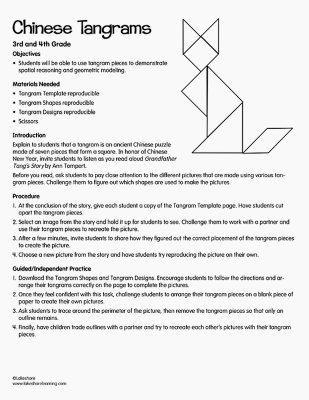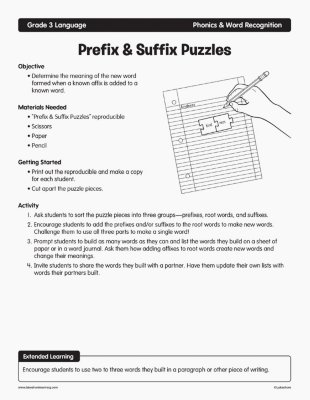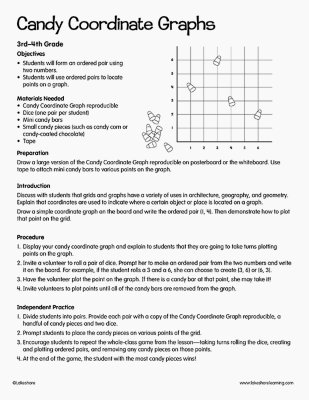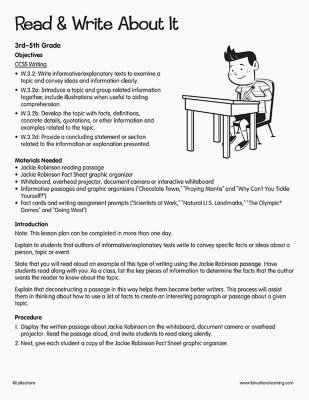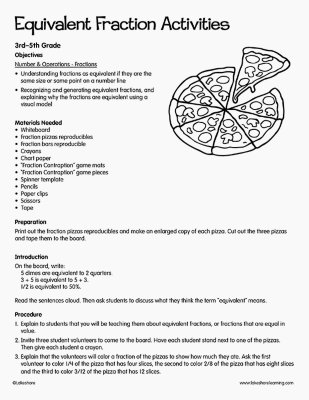Narrow by Grade
- Infant (0)
- Toddler (0)
- Preschool (0)
- Pre-K (0)
- Kindergarten (0)
- 1st (0)
- 2nd (0)
- 3rd (5)
- 4th (1)
- 5th (0)
- 6th & Up (0)
Grade
Narrow by Age
- 0-18m (0)
- 18-36m (1)
- 3 yrs. (0)
- 4 yrs. (5)
- 5 yrs. (4)
- 6 yrs. (4)
- 7 yrs. (4)
- 8 yrs. (5)
- 9 yrs. (1)
- 10 yrs. (1)
- 11 yrs. & Up (0)
Age 8 yrs.
5 results for "24 piece floor puzzles/"
Filters
Clear All
Chinese Tangrams
3rd Grade
Objective Students will be able to use tangram pieces to demonstrate spatial reasoning and geometric modeling. Materials Needed Tangram Template Reproducible Tangram Shapes Reproducible Tangram Designs Reproducible Scissors Introduction Explain to students that a tangram is an ancient Chinese puzzle made of seven pieces that form a square. In honor of Chinese New Year, invite students to listen as you read aloud Grandfather Tang’s Story by Ann Tompert. Before you read, ask students to pay close attention to the different pictures that are made using various tangram pieces. Challenge them to figure out which shapes are used to make the pictures.
View Lesson PlanPrefix & Suffix Puzzles
3rd Grade
Objective
- Determine the meaning of the new word formed when a known affix is added to a known word.
Candy Coordinate Graphs
3rd Grade
Objectives Students will form an ordered pair using two numbers. Students will use ordered pairs to locate points on a graph. Materials Needed Candy Coordinate Graph reproducible Dice (one pair per student) Mini candy bars Small candy pieces (such as candy corn or candy-coated chocolate) Tape Preparation: Draw a large version of the Candy Coordinate Graph reproducible on posterboard or the whiteboard. Use tape to attach mini candy bars to various points on the graph. Introduction Discuss with students that grids and graphs have a variety of uses in architecture, geography, and geometry. Explain that coordinates are used to indicate where a certain object or place is located on a graph. Draw a simple coordinate graph on the board and write the ordered pair (1, 4). Then demonstrate how to plot that point on the grid.
View Lesson PlanRead & Write About It
3rd Grade - 4th Grade
Objectives CCSS Writing W.3.2: Write informative/explanatory texts to examine a topic and convey ideas and information clearly. W.3.2a: Introduce a topic and group related information together; include illustrations when useful to aiding comprehension. W.3.2b: Develop the topic with facts, definitions, concrete details, quotations, or other information and examples related to the topic. W.3.2d: Provide a concluding statement or section related to the information or explanation presented. Materials Needed Jackie Robinson reading passage Jackie Robinson Fact Sheet graphic organizer Whiteboard, overhead projector, document camera or interactive whiteboard Informative passages and graphic organizers (“Chocolate Town,” “Praying Mantis” and “Why Can’t You Tickle Yourself?”) Fact cards and writing assignment prompts (“Scientists at Work,” “Natural U.S. Landmarks,” “The Olympic® Games” and “Going West”) Introduction Note: This lesson plan can be completed in more than one day. Explain to students that authors of informative/explanatory texts write to convey specific facts or ideas about a person, topic or event. State that you will read aloud an example of this type of writing using the Jackie Robinson passage. Have students read along with you. As a class, list the key pieces of information to determine the facts that the author wants the reader to know about the topic. Explain that deconstructing a passage in this way helps them become better writers. This process will assist them in thinking about how to use a list of facts to create an interesting paragraph or passage about a given topic.
View Lesson PlanEquivalent Fraction Activities
3rd Grade
Objectives Number & Operations - Fractions Understanding fractions as equivalent if they are the same size or same point on a number line Recognizing and generating equivalent fractions, and explaining why the fractions are equivalent using a visual model Materials Needed Whiteboard Fraction pizzas reproducibles Fraction bars reproducible Crayons Chart paper “Fraction Contraption” game mats “Fraction Contraption” game pieces Spinner template Pencils Paper clips Scissors Tape Introduction On the board, write: 5 dimes are equivalent to 2 quarters. 3 + 5 is equivalent to 5 + 3. 1/2 is equivalent to 50%. Read the sentences aloud. Then ask students to discuss what they think the term “equivalent” means.
View Lesson Plan